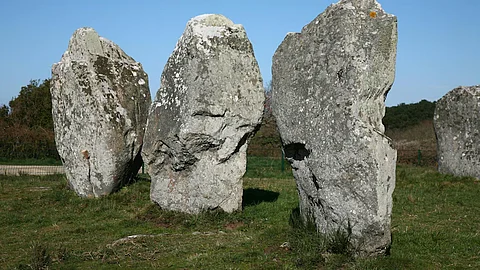
- Destinations
- Experiences
- Stay
- What's new
- Celebrating People
- Responsible Tourism
- CampaignsCampaigns
- Subscribe
- Buy Now

In a recent declaration, the Archaeological Survey of India (ASI) raised the Lianpui menhirs in Mizoram's Champhai district to the pedestal of Monument of National Importance. The inclusion places the site alongside some of India's most historically valuable structures, granting it protection under the Ancient Monuments and Archaeological Sites and Remains Act, 1958. Located in the eastern highlands of Mizoram, the Lianpui site has now joined the ever expanding list of north-eastern heritage sites formalised by the ASI.
The announcement came as part of ASI’s broader initiative to archive and protect lesser-known archaeological sites scattered across the northeast. The Lianpui site features an extensive arrangement of vertical stone slabs, commonly known as menhirs, believed to be associated with tribal burial and commemorative traditions.
Making this announcement, the ASI will naturally be in charge of the site's protection, documentation, and any potential excavation activities. It will also venture to make it easier for the site to be included in national and international heritage tourist circuits. Additionally, the classification creates opportunities for federal and state financing for community involvement and preservation.
Menhirs are standing stones that are vertically raised and usually have no inscriptions. They can be found all throughout Europe and Asia. These megalithic stones, which are believed to honour significant people, conflicts, or social occasions, are frequently connected to pre-Christian tribal civilisations in Mizoram and other regions of Northeast India. They are sometimes placed as part of ancestral worship rites or used to mark grave locations.
The Lianpui menhirs are specifically notable for their density and preservation, forming a complex that reflects a wide range of ritual and social meanings within Mizo oral traditions.
The Lianpui menhirs are located in Lianpui village, close to Mizoram's eastern border with Myanmar. It is part of the Khawzawl subdivision of Champhai district. Located in the Lushai Hills at a considerable elevation, the area is reachable only by road from Aizawl, which is about 190 km distant. Mizo villages make up the majority of the area's population, and their familiarity with the location has been of essence to its preservation over the years.
Despite its relative remoteness, researchers, historians, and domestic visitors have begun to take an interest in the site, particularly in light of recent official cultural authorities' documenting efforts.
According to the local customs, the menhirs were built in remembrance of those who made important contributions to their clans or communities. These erect stones were a supplement to guarantee that the deceased's legacy was publicly remembered and canonised, in contrast to tombstones. Some stones might even commemorate achievements in hunting, combat, or charity, for instance throwing large gatherings for a feast.
The height and position of each stone vary; some are more than two metres high. Although the form and clustering of the menhirs at Lianpui are similar to those of other megalithic traditions in northeast India, including those in Meghalaya and Nagaland, they are nevertheless different.
Oral histories passed through generations describe these stones as “Lungphun” or “Lungphun Ropui,” which loosely translates to 'noble stone arrays,' indicating their high ritual value.
The ASI’s declaration ensures that the Lianpui site will now be secure against encroachments, defacement, and unregulated tourism. Under the Monument of National Importance tag, conservation measures will entail regular site monitoring, landscape management, and heritage signage in regional languages, among other things.
There is also scope for archaeological surveys to determine the chronology of the stones and their broader historical context. Though traditionally dated through oral history, scientific carbon or lichenometric dating could further shed light on their age and construction phases.
In addition, local organisations and the Mizoram State Archaeology Department are expected to collaborate with ASI in documenting community narratives associated with the stones. These efforts will cumulatively feed into cultural preservation programmes and may help nominate the site for future inclusion in UNESCO heritage listings.
The Lianpui menhirs are part of a larger but significantly less documented megalithic tradition across northeast India. Sites in Lunglei, Aizawl, and Serchhip districts all have evidence of rock art, engraved stones, and similar menhir complexes. Nevertheless, many of these remain unprotected and at risk due to erosion.
Recent efforts by scholars and cultural bodies to map and research these sites reflect growing recognition and interest in the region’s archaeological richness, long overlooked in India’s mainstream history and heritage discourse.
The ASI’s recognition of Lianpui is thus symbolic, timely and strategic—it marks a shift towards a more inclusive heritage conservation that takes into account the distinct and diverse histories that are far flung like that of India's northeastern frontier.
(With inputs from various sources.)
